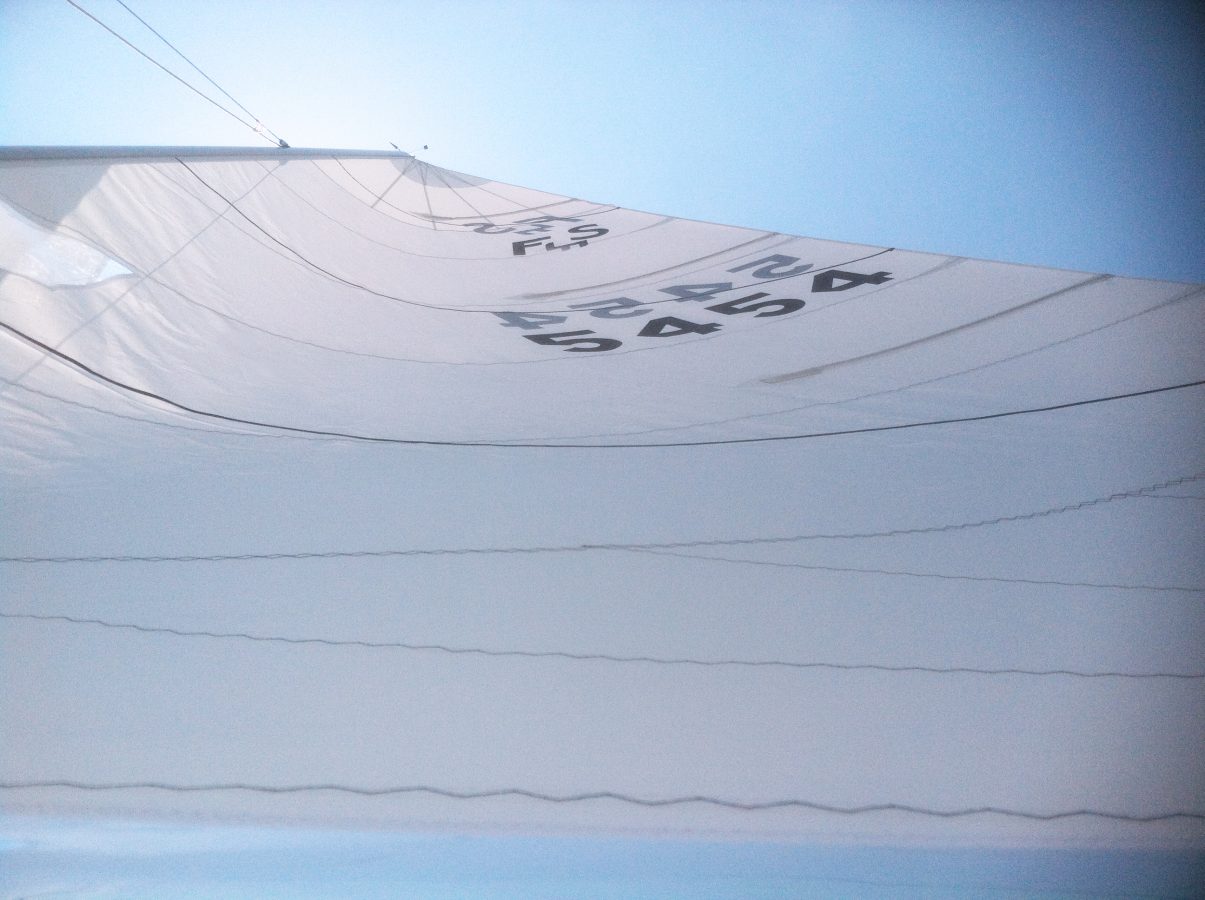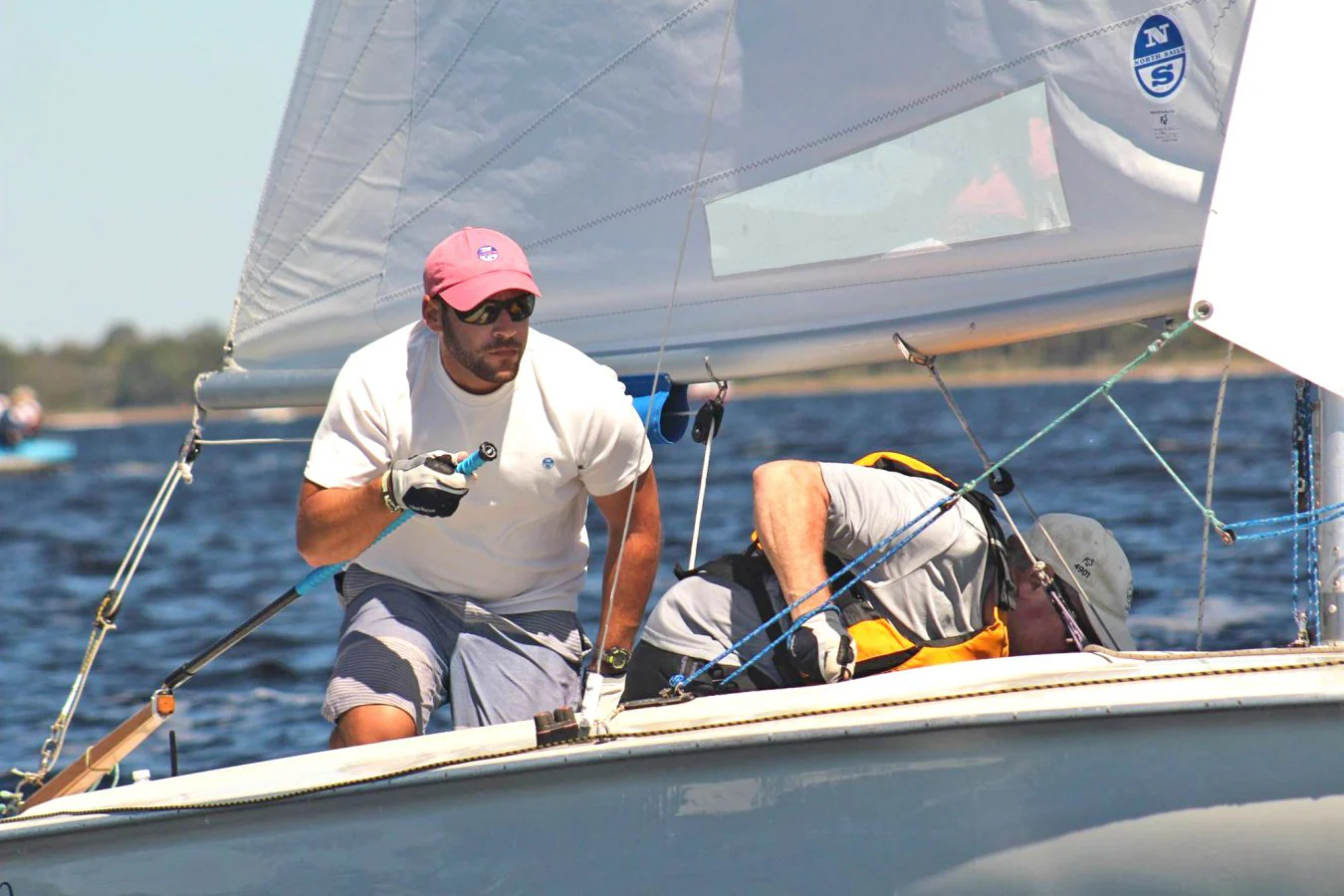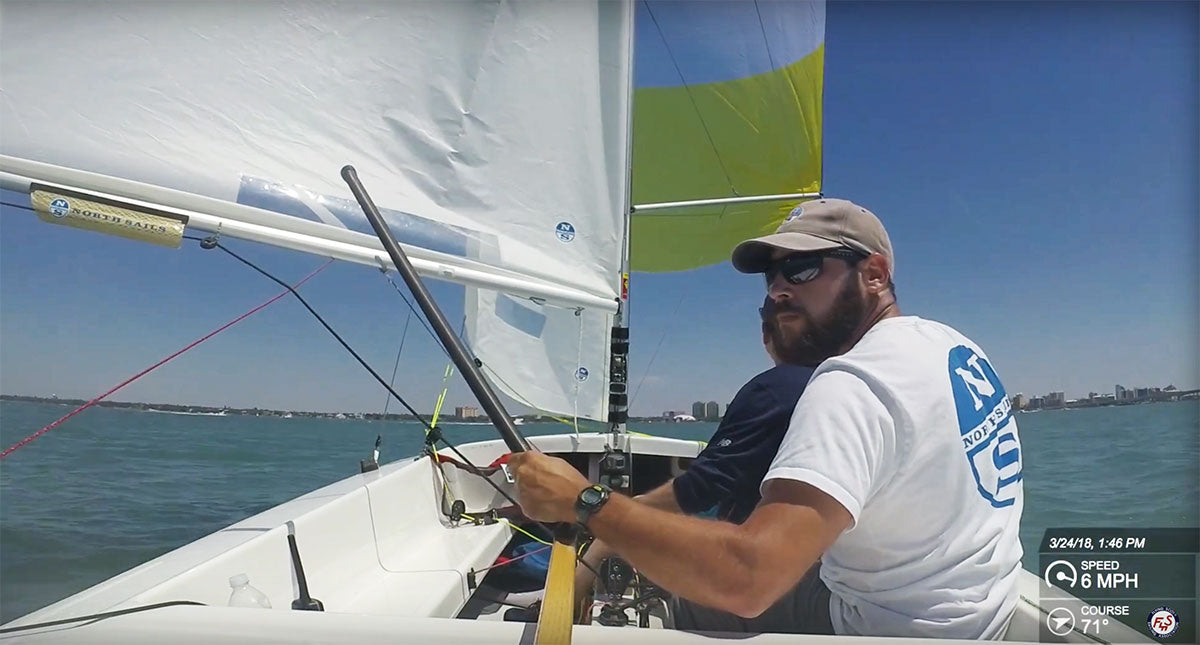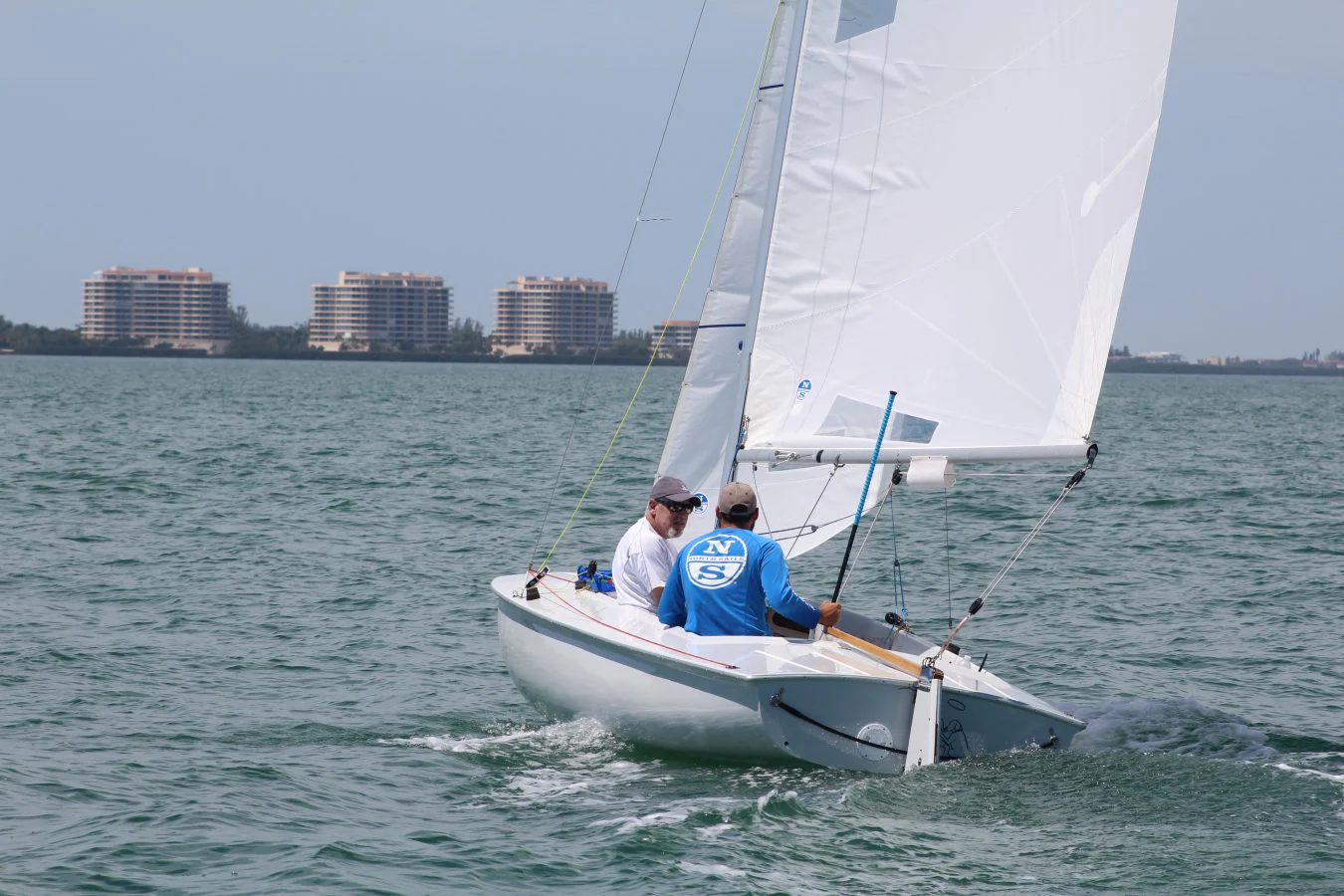NORTH SAILS BLOG
All
Events
Guides
News
People
Podcast
Sustainability
Tech & Innovation
Travel & Adventure

LET’S TALK FLYING SCOTS | Q&A WITH GREG FISHER
LET’S TALK FLYING SCOTS
Q&A With Greg Fisher
Experts Brian Hayes, Zeke Horowitz with Special Guest Greg Fisher lead a Q+A interactive session, open to all topics. Viewers brought questions and experts shared their answers and expert tips with the group.
READ MORE
READ MORE

LET’S TALK FLYING SCOTS | CHANGING GEARS
LET’S TALK FLYING SCOTS
Changing Gears
Join Class Champions Zeke Horowitz and Brian Hayes for an informal web talk covering tips on how the top teams change gears and keep the boat going fast!
READ MORE
READ MORE

VIDEO: FLYING SCOT SAIL TRIM
FLYING SCOT MAINSAIL TRIM WITH ZEKE HOROWITZ
Video With Tips and Advice on How to Trim the Mainsail on a Flying Scot
We’ve all heard it one hundred times…. “Boat speed is King.” That’s all well and good but how are we supposed to know how to achieve it?? In this video with North Sails expert Zeke Horowitz, you’ll be able to see and learn how, when, and why to play the controls on your mainsail while sailing upwind.
The key is to remember that sail trim needs to be dynamic – you need constant tweaks and adjustments to keep the boat moving as fast as possible for as long as possible.
You’ll learn to develop a short checklist based on feel and visuals so that you’ll know what needs to be adjusted and when. The important elements to check on for proper mainsail trim are:
Feel on the helm
Heel of the boat
Leech tension/twist
“Speed wrinkles” in the lower 1/3rd of the sail.
You want to generate the right mix of all of these elements with a dynamic trim approach so that you can sail with the boat as flat as possible, as steady as possible (constant heel angle), and at as high a pointing angle as possible without losing center board flow.
Boat speed is King and it’s just that simple. 😉
We would like to thank Eric Bussell and the Flying Scot Class for the opportunity to be involved in making this video.
READ MORE
READ MORE

VIDEO: TACKING ON A FLYING SCOT
TACKING ON A FLYING SCOT WITH ZEKE HOROWITZ
Video With Tips and Advice on How to Tack on a Flying Scot
Nailing a perfect tack is often the difference between getting that first cross off the starting line, sneaking it in at a weather mark layline, or being able to pinch off a boat just before the finish. Tacking your Flying Scot can have a lot of variables based on the specific conditions you’re sailing in or the exact scenario you’re in. Practice makes perfect, and as you continue to improve you’ll be able to dial in the subtle nuances of all of these variables.
There are a couple of keys to focus on and practice so that when the time comes to execute the perfect tack, you are prepared and ready to nail it!
Try to bring the main sheet in a bit as you start to turn up at the beginning of the tack. This helps the boat turn up without using as much rudder.
Then, ease the main sheet as you go through the tack so that the main sail is slightly eased and in acceleration mode once you get onto the new tack.
Keep your eyes forward on the jib tell tales so that you can hit the proper exit angle.
Get comfortable with your hand switch so you don’t feel rushed.
Finally, understand the feel of the boat in terms of heel/roll so that you can decide when and how quickly to cross sides to keep the boat as steady as possible.
In this video, listen to North Sails expert Zeke Horowitz as he provides tips and advice on how to tack on a Flying Scot.
We would like to thank Eric Bussell and the Flying Scot Class for the opportunity to be involved in making this video.
READ MORE
READ MORE

LESSONS LEARNED AT FLYING SCOT NORTH AMERICANS
LESSONS LEARNED AT THE FLYING SCOT NORTH AMERICANS
Expert Zeke Horowitz Shares His Tricks Of The Trade
Zeke and Jay Horowitz, 2018 North American Champions © Steve Bill
The 2018 Flying Scot North American Championship at Rush Creek Yacht Club in Heath, TX could have been called the “How to Run a Major Championship Clinic.” From the outset of the event, it was obvious that RCYC along with Fleets 209 and 23 had pulled out all the stops to make this regatta stand out as an all-time great in this class’ rich history. We had a super energetic and hard working Regatta Chair in Mike Brown, who was extremely active in helping make sure everyone had what they needed, and felt organized and welcomed. He had ensured that this sentiment was expressed at every turn from registration to measurement to launching and hauling out. There were plenty of cold waters (and other beverages…) and smiles at every turn. But perhaps the biggest shout out needs to go to local legend Bob Gough who recruited an absolutely World class PRO in Mark Foster (a sailing legend in his own right) who, in turn, assembled a brilliant team of volunteers who kept the racing as square and fair as possible in conditions that regularly delivered 30+ degree wind shifts. The RC communication on the radio was perfect and seemingly miraculously, they were always ahead of the big shifts and velocity changes. Kudos to the tremendous team that put together an absolutely flawless event.
I don’t think anyone on the racecourse managed to make the sailing look as easy as the RC made the race management look. We were sailing on the Southwest corner of the Lake so it wasn’t always easy to see the breeze before it touched down right off the coast. It was very common for a beat to feature three or four 30-degree wind shifts with the pressure ranging anywhere from eight knots all the way up to the high teens. You could quickly watch a boat go from being in your mainsail window 1,000 yards to leeward of you to all of the sudden being directly on your bow 1,000 yards in front of you! Needless to say, keeping your wits about you was important but not easy. These condition is easy to get frustrated in and nearly impossible to always be in the right place at the right time. But I choose to think of this condition as one of the easiest conditions to make decisions in. Some readers who experienced this first hand might be shutting their computers and decidedly never listening to me again… but first let me explain!
When sailing in these conditions on a windward leg that is around a mile long, you are very rarely going to be in the same breeze as your competitors (especially those on the other side of the course). You can’t control what the breeze is doing, and you can’t control the decisions your competitors are making. So, all you can worry about is getting your boat to the weather mark as best you can in the breeze available to you. It’s as simple as: “Am I lifted or headed and am I in the most pressure imminently available to me?” THAT’S IT.
We learned time and time again that the breeze was oscillating and it always seemed to come back eventually. Even when it seemed really bleak, the new pressure would drop in, the direction would shift back, and you could tack and be right back in front with leverage. This was not a condition where you could chase shifts or puffs.
When we saw the boats on the opposite side of the course go way up in a big lift with breeze that we didn’t have we would try to take a deep breath and come back to, “am I lifted or headed? And am I in the most breeze imminently available to me?” That was the only question we would make decisions on. Never, “we need to go get what they have.” We couldn’t get what they had… It wasn’t available to us. So if we were still in a relative lift and were still heading towards the most breeze imminently available to us, we would hang in there and wait until our moment to go up in a big lift with pressure that the other guys didn’t have. If you tack to try to go get something that other people on the other side of the course have, by the time you get there, it’s going to be gone and the boats you just left on your side are now going to have their shot. That’s called being “out of phase.” There were countless occurrences of this at the NAC’s but 9.9 times out of 10, the team that stayed patient and disciplined and kept sailing on their lift, would win out in the end. So to me, this is simple racing because all you can worry about is yourself and sailing on the best number in the best breeze available to you. Note that in this condition you oftentimes have to value sailing on the right tack over clear air. Staying on the lift in dirty air was usually better than sailing a big header to clear your air. This is tough decision to make but it’s a very important one for staying in phase! When in doubt point your boat at the mark.
Having top notch boat speed makes being patient a whole lot easier.
The majority of the regatta was sailed in flat water and more than ten knots. This is pretty powered up conditions for the Flying Scot and there were a couple of sail trim items we focused on to make sure our speed was there. Since we were rarely looking for power and the water was so flat, relative to how much breeze there was, we focused on trying to achieve a nice flat sail set up. If we had the same amount of breeze but more waves/chop, we wouldn’t have been so aggressive on the flat sails. We had the jib halyard tension set so the luff of the jib was mostly smooth. We still stuck to having it a touch too loose, but it was a click tighter than it would have been if there was a bit of chop. If there were any wrinkles coming off the snaps, they weren’t longer than about six inches. We rarely used weather jib sheet because we didn’t need any extra power in the foot and we sheeted the leeward sheet a tad harder than usual too. We had the leech tell tale just on the verge of stalling as soon as we were up to speed. This helped us keep the jib nice and flat and achieve adequate pointing. The foot of the jib had a hint of curl when we were fully trimmed. We set the main halyard so that the luff was smooth when sailing downwind.
In the breezier conditions this meant that the luff was a bit loose for the upwind portion of the race. So we played the cunningham more often than usual so we could set the “speed wrinkles” coming off the luff. The wrinkles at the bottom of the main came off the luff and made it about half way back towards the leech. The wrinkles above that one got progressively shorter (closer to the luff) as they made their way up the sail. Above the vision window in the luff of the main, the luff was mostly smooth. So in the biggest breeze we had we were pulling the cunningham grommet down by up to about four inches to keep our speed wrinkles where we wanted them. Lastly, we made sure the outhaul was nice and snug to keep the foot of the main flat. There was a noticeable tension wrinkle in the foot when we weren’t trimmed in. I would have called our outhaul tension 90%. After that it was all about playing the vang and main sheet through the puffs and lulls to try to achieve a steady angle of heel. Having a crew counting the puffs and lulls so the skipper can be ready to make the appropriate adjustment was key.
I’d like to thank all of the dedicated Flying Scot class members and class officers for all the hard work making it down to Rush Creek Yacht Club and helping to create the type of environment that makes everyone want to keep coming back. This is a special boat and a special fleet and it would be nothing without all of the spectacular personalities that define it. We’re looking forward to seeing everyone again real soon!
Randy Pawlowski and Rafael Melendez, winners in the Challenger Division. © Steve Bill
READ MORE
READ MORE

VIDEO: FLYING SCOT JIBING TECHINQUE
FLYING SCOT JIBING: STEP BY STEP
How to do a proper jibe in the Flying Scot
Whether you are racing a super yacht, a foiling catamaran, or a traditional small keel boat having top notch boat handling skills is one of the most important factors in having a successful performance while racing. Being able to whip off a perfect jibe in every condition will allow you to have confidence to execute your game plan without hesitation which can turn into many boat lengths in gains throughout a run. In this video, Zeke and Jay Horowitz focus on proper jibing technique in the Flying Scot.
“Make sure you understand the subtle differences in technique for each condition and always communicate with your team. It is really good to come up with a repeatable dialogue between skipper and crew so that you do everything the same way every time. On our boat, we do a hand off of the sheet and guy at the beginning and the end of the maneuver and we are sure to say “my sheet, my guy” every time so that there is no mistake in the hand off. We also try to focus on doing each step smoothly without rushing. It is more important to keep the spinnaker full, and the boat steady through the maneuver than it is to rush through it all and risk a mistake. As you get better at executing each step, you’ll be able to do them faster but it’s important not to rush”. – Zeke Horowitz, 2018 Flying Scot Midwinter Champion
Good luck and have fun!
Learn more about North Sails Flying Scot products.
READ MORE
READ MORE

FLYING SCOT MIDWINTERS - AN EXERCISE OF PATIENCE
FLYING SCOT MIDWINTERS: AN EXERCISE IN PATIENCE
Maximizing success in big fleet racing with unpredictable conditions
Zeke and Jay Horowitz, 2018 Flying Scot Midwinter champions
As a 9 year old learning to race on Sarasota Bay, I learned quickly what a beautiful venue it was to race small sailboats. From the tropical colors, warm climate, and warmer hospitality, the Sarasota Sailing Squadron has always been one of my favorite places to go back to visit and sail. Having done so much sailing there over my life, I thought I had the venue pretty dialed in from a predictability standpoint. If it’s out of the North or South, it is a boat speed race – limit boat handling, play a side, and be conservative. If it is from the West, it’s a seabreeze – play the oscillations and look for puffs coming off of Longboat Key. If it is from the East, favor the left but keep your eyes open as the offshore breeze can be all over the place. Or so I thought…..
This year’s Flying Scot Midwinters was anything but predictable and the key to success was patience along with quick problem solving and a “never say die” approach to the shifts. PRO Fairlie Brinkley and his team on the Race Committee did a masterful job of keeping the racing square and fair through 40+ degree shifts and wind speeds that didn’t always get along with the class!
DAY 1
We all knew that day 1 of racing was a “survival day” with light winds predicted out of the East – the most unstable direction on Sarasota Bay. With no discards in the series, it was going to be imperative to try to avoid the big mistakes and stay as conservative as possible to try to keep the point total down. The regatta was not going to be won on Day 1 but it could certainly be lost if you got caught on the wrong side of a beat. Doing our homework before each race was super important.
We found it very useful to be out on the race course early so we could sail up the beat a couple of times and learn what the wind was doing.
We found that there were definitely shifts in both directions but the shift that seemed to stay the longest was from the right.
We also learned that getting into the velocity (which is pretty easy to see on the sea green waters of Sarasota Bay) was of paramount importance.
It was also key to remember not to go too much into “cover the fleet mode” near the top of the race course. There were too many shifts and velocity changes in the last quarter of the beat with hundreds of boat lengths to be gained or lost.
Taking in all that we learned in our pre-race home work we developed a game plan to error towards the right side but keep our heads out of the boat and when all else failed – point the boat at the mark. Something that sounds very basic but when you can be confident that the wind will generally not stay steady for more than about 2 minutes, it’s crucial to spend every minute on YOUR lifted tack. Even if other boats had more of a lift or more velocity – there was nothing you could do about it. So just point your boat at the mark, be patient, and look for the next shot of pressure.
Throughout the 2 races, we found ourselves in some tough spots where the frustration threatened to get the better of me. But we tried to remain patient and remember our homework. A bit of discipline was needed to to keep “hitting singles” instead of going for a home run. This mentality allowed us to pick off the few boats in each race to finish the day having accomplished our goal – SURVIVING!
DAY 2.. Too much wind, no racing.
DAY 3
With day 2 cancelled due to high winds, we knew day 3 was going to be a long 3 race day. With a direction predicted to stay mostly out of the South, I thought I could rely on my years of experience on Sarasota Bay and plan on leaning on boat speed and good starts to bang out some good races. But this day proved to be a real challenge as the breeze was anything but steady.
After the first beat of the first race, it was clear that the sea breeze was going to have its way with us throughout the afternoon. With the sea breeze trying to pull the wind hard right, and the gradient fighting to keep the breeze out of the SE, we saw wind shifts upwards of 40 degrees with velocity differences in a range of 10 knots.
About 3 minutes after the start of the first race, we found ourselves about 500 yards behind the leaders. And we had a great start! After a couple minutes of pure panic, we remembered that if it was possible to get that far behind so quickly, it was sure possible to make it back quickly too!
We were committed to the left side so we found our opportunities to get back to the right and in touch with the fleet when we could so that we could have a chance at a big gainer on the downwind.
It is crucial to remember that in this sort of condition, the downwind legs have as much to be gained as the upwinds legs. Keep your eyes looking back and find the big pressure. Don’t be afraid to change course drastically (by gybing or heating up) in order to get into the maximum pressure.
Keeping our heads out of the boat, we were able to rally on the run and then see the big pressure working its way down the right side before we turned to go back upwind. Committing hard to the right allowed us to get back into the top three and hang onto it for the final run. This comeback proved to be the saving race of our regatta. For the rest of the day we favored the right as the sea breeze kept trying to work its way onto the bay, but we found several nice gains by finding some of the remaining gradient on the left. This was a day that left most of the fleet with raging headaches as you could never stop thinking and planning ahead for your next move.
While boatspeed is always king, this regatta had everything to do with keeping your head out of the boat and playing the proverbial chess game to set yourself up for your next play.
We worked on dividing the race course into ¼ ‘s with the top ¼ being about 1000 yards past the weather mark. By continuously looking at each ¼ we were able to try to plan out the next step based on what we saw at that moment.
For sure, our predictions were not always correct, but keeping patience and quick thinking at a premium, we could keep the boat in spots where we wouldn’t lose too much if we got it wrong, but that we were in a position to make big gains if we got it right. This approach let us hit lots of singles throughout the week without the accidental strike-out by going for a home run. This was an important reminder about how to approach big fleet racing in unpredictable conditions.
A HUGE thank you goes out to the Sarasota Sailing Squadron and all it’s volunteers. We will be sure to go back at every possible opportunity to race our Flying Scot.
2018 Flying Scot Midwinters
1. Zeke Horowitz / Jay Horowitz
2. David Ames / PJ Buhler *
3. Jeff Linton / Andy Hayward
6. Tyler Andrews / Andy Fox
8.John Kreidler / John Wake
9 .Ned Johnston / Ryan Donahue
10. Tom McNally / Cindy Taylor / Mike Taylor
* Denotes Partial North Sails Inventory
Full results
Learn more about North’s Flying Scot designs.
READ MORE
READ MORE

FLYING SCOT WIFE-HUSBAND CHAMPIONSHIP
FLYING SCOT FAMILY SAILING: WIFE-HUSBAND CHAMPIONSHIP
Couples gather in Rockport, MA for a fun, competitive sailing event
Race one winners Sharon and John Wake
It is fair to say that the Flying Scot Class is one of the biggest supporters of family sailing in the US and the Association strongly supports and encourages families to sail and race together. To that end, the class holds an annual Wife/Husband North American Championship which is, perhaps, the most well attended and competitive spouses-only event in the country. This years W/H NAC, which attracted 29 teams, was held in beautiful Rockport, MA and hosted by the Sandy Bay Yacht Club.
The teams arrived Friday throughout the day and after rigging the boats they were hooked up to the SBYC hoist for the 15-30 foot (depending on the tide) descend into Rockport Harbor where all 29 boats spent either on club docks or courtesy moorings. On Friday evening North Sails Expert Brian Hayes gave a short tuning and trimming talk to the group going over rake settings, vang tension and sail trim tips before the group dispersed throughout the town to enjoy the area restaurants and shops.
PRO Stephen Oulette greeted the group on Saturday morning with the traditional competitors briefing with the exception of mentioning that the protest committee would not be hearing any “intra-boat” disputes! Even though all the teams were ready to roll the breeze was not, and a 1 1/2 hour postponement was whittled away reviewing some archived Scot footage that Brian had from previous events and sharing tips with the fleet.
Saturday afternoon mustered up enough breeze to create tricky “current vs. breeze” conditions with large position changes in both fleets. Sharon and John Wake figured it out in Race 1 with a 2 minute race win while Amy and Jeff Linton sailed through the fleet in Race 2 for another convincing win.
Sunday brought a fresh, new wind direction and more velocity. Some teams used the wind speed/marital harmony equation and opted to sit out the days races, but a majority of the gang hit the water in a fresh 15 mph of breeze with big, open water, waves testing their abilities. Those who ventured out were rewarded with two more great races in a consistently softening breeze with Amy and Jeff Linton leading the way in both races to win the 2017 Wife/Husband Championships with 5 total points.
Full Results
Tyler and Carrie Andrews with winners Amy and Jeff Linton in front
Regatta Chair Margot Hintlian and Ralph Block
Charlie and Cindy Clifton
READ MORE
READ MORE

FLYING SCOT TUNING GUIDE
BOAT PREPARATION
MAST AND SHROUD TENSION
The Loose Rig
To measure the aft rake of your mast, hoist a tape measure on the main halyard and hold it tight at the intersection of the transom and the rear deck. This measurement (without your jib up), should be 28’ 4” to 28’ 5 1/2”. On our boat we have placed a channel adjuster above the deck at the joint of the forestay and the wire attached to the toggle. This allows us to quickly adjust the rake and lengthen the forestay if necessary.
To measure the “slop” of the rig, you need to measure the forward rake of the mast. With the tape still hoisted, push the mast forward until the shrouds restrict it. The difference between this forward measurement and the aft measurement should be approximately 2-3”.
The Tight Rig
The tight rig tuning is only functional with the jib cut for this tuning. A Loose Rig, or even a Snug jib put on a tight rig will be too flat, especially in medium winds.
First, drop your shrouds as low as possible in your channel adjusters. This should put the very bottom of the swage fork on your shrouds just barely above the actual chain plate that exits the hull. Raise the mast; hook your jib halyard to your bow plate (and perhaps tie your spinnaker halyard on the bow plate as well as a safety). Tighten the jib halyard until tensioned close to the suggested tension of 240lbs. We use a 3/8” socket wrench in the halyard box to crank the rig up tight enough. The standard aluminum cranks will break if used. It may be a trial and error process until you’ve reached the proper rig and tension. However, once achieved, you will not have to readjust the rig again! We suggest setting your rig up with the rig tension between 220 and 250 pounds. If less than 220, too much headstay sag will develop in medium winds, if more than 250; the mast may be pushed out of column in heavier winds.
The rake measurement, measured with a tape hooked on the main halyard to the joint of the transom on the back deck, should be very close to 28’4”- 28’5”. Farther forward than 28’5 1/2” will result in too “light” of a helm and the need to heel the boat more to keep in balanced. More rake than 28’3” will create too much weather helm.
Snug Rig Jib
The Snug Rig jib will tune very similar to the Tight Rig, using the same methods and tools above.
The rake measurement should still set very close to the 28’ 4”-28’ 5”. The rig tension will be considerably less then the tight rig, however. Set the rig to 80-110 lbs measured on the forestay.
NO MORE TOGGLE
It is no longer necessary to use the toggle to set your rake, jib luff tension or slop in the rig. In fact, you will never ever need to look at it again; your forestay will take the entire rig load while your jib halyard will simply adjust cloth tension.
RUDDER BLADE
In the past we have indicated in our Tuning Guides that the angle of the rudder blade to the rudder head should be set so the blade is much closer to parallel to the rudder head than comes stock from the factory. This has meant moving the blade and redrilling the rudder blade hole.
We have found that this change is not necessary and in some cases has perhaps contributed to rudder blade bending due to increased leverage on the blade.
Instead we feel confidant that setting the rudder blade angle similar to what come stock from the factory (the forward lower tip is approximately 5” aft of a straight line tangent to the forward edge of the rudder blade and parallel to the forward edge of the rudder head) increases the strength of the rudder blade without compromising speed or pointing ability.
SAIL TRIM
MAIN SHEET TRIM
The main should be trimmed so that the upper batten is parallel to the boom (sighted from under the boom looking up the sail). In lighter winds, or when sailing in a great deal of chop, it is helpful to ease the mainsheet slightly so the upper batten is angled out approximately 5º. In drifting conditions, when the boom is hanging on the leech and hooking the upper batten, set the upper batten parallel to centerline of the boat. Only in drifting conditions should the main be trimmed this way, as this will place the boom approximately 2’ (61 cm) off from centerline.
In very heavy winds, with the help of the boom vang, set the mainsheet tension so the upper batten is again angled outboard approximately 5º from parallel to the boom. It is important, in winds above 15 mph, to apply heavy boom vang tension so the mast and boom will bend correctly to sufficiently flatten the sail. When proper vang tension is applied it is not unusual that the boom be deflected from the straight line nearly 3 to 4” (7.6 to 10.2 cm) in heavy breezes. This heavy boom vang tension will help make playing the main much easier, as the sheet will not have quite as much strain as it does in even moderate winds.
Note: Make sure when rounding the windward mark that the boom vang is eased off so more strain is not applied to the mast and boom!
MAINSAIL STEERS THE FLYING SCOT
The mainsail is very important in steering the Scot. The skipper should always hold his mainsheet and be ready to ease it quickly when he feels an increase in his weather helm (i.e. load on the helm acts as a brake). When the boat is tracking well again, and the helm is balanced, he should slowly trim the mainsail back in.
Note: Double check that your mainsheet swivel cleat is angled properly for easy release in a puff. It is dangerous, and slow, to have to use your foot to kick the sheet free from the cleat to release it!
CUNNINGHAM/MAIN HALYARD TENSION
Pull the Cunningham just tight enough to leave a hint of horizontal wrinkles off the lower one-third luff of the sail. With the North Flying Scot main, it is better to err towards being too loose than being too tight. Of course, in a breeze it will require much more Cunningham tension to smooth the sail, but there should still be a hint of horizontal wrinkles.
It is important to start with the proper main halyard tension at the dock. There is a definite tendency to over-tension the halyard and pull all the wrinkles from the luff before any Cunningham is applied. This is especially important to avoid in lighter winds.
BOOM VANG
Downwind, trim the vang just hard enough to keep the boom down and the leech supported on the main. Still use the guide of setting the upper batten being set slightly out from parallel to the boom. When the boom vang is trimmed correctly on a beam to broad reach, the telltale should fly straight off the leech at the upper batten. There is a tendency for the boom vang to be pulled on too hard when sailing downwind, especially in light winds. This will over- tighten the upper leech and, due to the side bend of the mast, over flatten the mainsail. However, it is also easy to “under-vang” in heavier winds downwind and loose valuable power from the top of the main. Be conscious of your top telltale.
As previously mentioned, upwind in heavy air, the vang is set hard enough to restrict the upward movement of the boom to just allow the upper batten to ease no more than 5° to 10° past parallel to the boom. In these conditions, as mentioned, the mainsheet simply acts as a traveler and allows the boom to move mostly sideways and outboard. With each wind velocity the vang tension applied depends primarily on crew weight. Lighter weight crews will tension the vang earlier due to becoming overpowered earlier, while heavier crews might not need boom vang tension until much heavier winds.
OUTHAUL
Your North mainsail is constructed with a shelf foot so it is possible to make the lower half of the main deeper when sailing downwind. Usually the outhaul is tight enough upwind so that there will be only a 1 1/2” to 2” (3.8 cm to 5.1 cm) gap between the side of the boom and the shelf-foot seam in the middle of the foot. In heavy winds, pull the outhaul tighter to close the shelf and flatten the main. In extremely heavy winds, above 18 mph, the outhaul should be tight enough so there is a hard crease from the tack to the clew. In lighter winds or choppy seas, ease the outhaul until the gap between the side of the boom and the shelf seam is 2”. When going downwind, ease the outhaul (if there is time and opportunity) until the gap is a full 3-4”.
JIB LUFF TENSION
As wind velocity changes, it is necessary to change the luff tension on your jib (such as the Cunningham on the main). Simply crank your jib up tight enough to barely leave a hint of wrinkles along the luff. These will appear as “crow’s feet” off each snap. Never leave the halyard tension loose enough so that there is “sag” between each snap, but only crank the halyard so tight that the crow’s feet are removed in heavy winds when overpowered. There is no need to adjust the lashing at the head of your jib if you use the above suggestions.
JIB LEAD POSITION
In most conditions, keep the leads maximum forward on the tracks. In heavy winds and when overpowered, move the leads all the way aft on the tracks.
JIB SHEET TRIM: WINDWARD SHEET TRIM
Proper leeward and windward jib sheet tensions are important for top upwind performance in the Flying Scot. In light and moderate winds, the windward sheet is tensioned upwind in order to pull the clew of the jib to windward of the jib lead track. This will help narrow the slot (since the Scot’s jib slot is normally too wide) and make the lower sections of the jib more powerful.
To set up the trim for upwind sailing pull the leeward sheet until the foot of the jib is just smooth and not curled. The foot should be relatively flat and not baggy, but not so flat that the very bottom of the sail begins to curl up. Next pull in the windward sheet until the clew of the jib falls directly over the middle of the seat. On our boat we actually place a tape mark in the middle of the seat to make it easier to eyeball the position of the clew.
With the weather sheet trimmed the jib foot will become much fuller which will increase the boat’s power and ability to accelerate. Once the boat is up to top speed pull the leeward sheet again until the foot is flatter and the upper batten is angled straight back nearly parallel to the center line of the boat.
When hitting chop or sailing into a lull, ease only the leeward sheet so that the top batten angles outboard 15 to 20 degrees. When back up to speed, pull the leeward sheet back in until the top batten is nearly straight back. Throughout this acceleration process the weather sheet is never eased unless the boat is sailing in very light, nearly drifting conditions or very heavy winds (see below). In this condition the boat will be nearly “close reached” around the course and the weather sheet, therefore will not be applied.
We have found that in heavy winds and when the boat is overpowered the windward sheet will be well eased and at times all the way off. This is necessary because as the mainsheet is eased, you will need to help maintain an open slot between the jib and the main. Also this allows the leech of the jib to open up and be more forgiving, both in terms of heel and steering.
ATTACHING JIB SHEETS
It is best to tie the jib sheet onto the jib with an overhand know so that the knot is 6” away from the clew of the jib. This is important so that when windward sheeting pull from the windward sheet is primarily across instead of directly down. With the knot 6” away from the clew the windward sheet attaches to the jib lower and therefore pulls more sideways.
If you are sailing with 2:1 sheets, the blocks should be tied about 6” from the clew of the jib.
CREW WEIGHT
While the Flying Scot will perform with an extremely wide range of crew weights, we suggest trying to sail with as close to 360 to 450 lb. as possible.
CENTERBOARD
Keep the board all the way down when sailing upwind in all conditions. In heavier winds you may find that the helm balances even better when the board is rolled back from the bottom of the hump 1” to 2”. In very heavy, near survival, winds lower your board only to where the rollers are just touching the flat at the bottom of the hump.
Downwind remember to pull the board up to match the helm balance. On a reach it is not unusual for the board to be as high as 3/4 of the way up when it is breezy.
Remember that the only goal is to balance the helm when sailing off the wind and pulling the board up until the boat will almost sail itself when nearly flat will greatly help to improve the boat’s speed.
SPINNAKER TRIM
Always sail your North spinnaker with a 6” to 12” curl in the luff. Careful concentration is necessary. Use short, smooth, in and out motions on the sheet to keep the spinnaker trimmed correctly. Try to keep from jerking the sheet when the spinnaker begins to collapse! Keep the clews even at all times through adjustments to your topping lift (pole).
In some conditions it is difficult to see the leeward clew behind the mainsail, so you can use another guide, which is to adjust the pole height so that the center vertical seam in the spinnaker is parallel to the mast. We suggest easing the halyard so that the head of the spinnaker is 6” off the mast.
When running, in nearly all conditions, we suggest sitting fairly far aft in the Flying Scot. It is not unusual for the skipper to be up against the aft side of the cockpit with his crew just in front of him, especially when windy.
SHIM YOUR BOARD
On Scot’s older than 5 years it may be helpful to shim the centerboard and trunk for top upwind speed. When sailing through chop an unshimmed board can slop around and become quite inefficient. By gluing fiberglass battens or applying thickened epoxy to the inside of the trunk where the bottom meets the inside of the trunk, the board can be shimmed tightly so that sideways slop will be minimized when the board is fully lowered.
STEERING THE SNUG AND TIGHT RIG JIBS
In light to medium winds, these jibs will steer just similar to the loose rig style jib. When pointing high, allow the weather telltale to stall, but never sail lower than the leeward telltale on the luff of the jib-streaming straight aft. When accelerating, both telltales should be straight aft.
However, in breeze, when the boat is overpowered, it will be unusual, unless sailing through very large waves, that the weather telltale will not show a stall. In fact, in very breezy conditions, the luff of the jib will actually be breaking as far back as 12 inches. With the tight rig jib the groove is quite wide and when trying to accelerate, both telltales will nearly be straight aft, and when sailing in point mode and when trying to depower, again, the luff of the jib will be actually breaking.
When steering in the upper ranges of the “groove” don’t be afraid to allow the windward telltale, and at times even the luff of the jib, break.
SAIL CARE
Your North Sails are constructed out of the best materials on the market today. We make sure of this by testing every roll of cloth we use. Through proper care and maintenance your sails will give you the performance you have come to expect from a North sail.
The most important factor for a long life for your sails is to watch them for signs of wear and tear in high load and chafe areas. Be sure to wash the sails off with fresh water and dry the sails thoroughly before storing. A dry, mild climate is best. Excessive heat can cause problems with the sails due to the possibility of shrinkage. It is best to roll the mainsail and jib.
MAINSAIL
When hoisting and lowering the sail try to minimize the amount of creasing or wrinkling of the sail. Every time the sail gains a crease the cloth breaks down that much faster. Always have someone contain the leech and luff during these procedures.
The battens can be left in the sail without any problems. Be sure to roll the sail down the leech so that the battens will not twist. This could cause damage to the battens.
JIB
When rolling the jib keep the battens perpendicular to the leech. Pay special attention to the battens and batten pockets for wear and tear.
SPINNAKER
The spinnaker is fairly straightforward. Be sure to repair all tears and pulled stitches. Folding the sail when storing is best.
Rev. R03
READ MORE
READ MORE





















